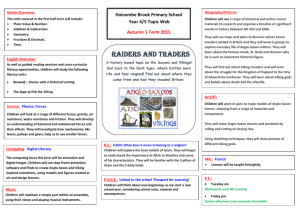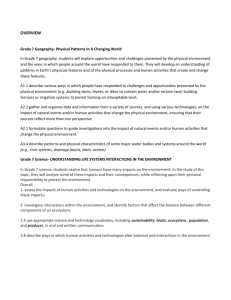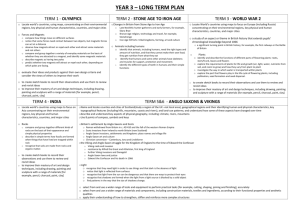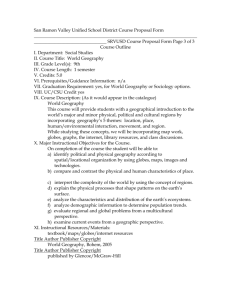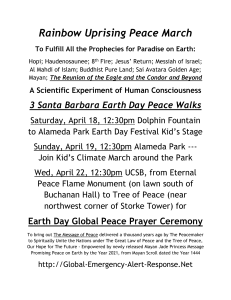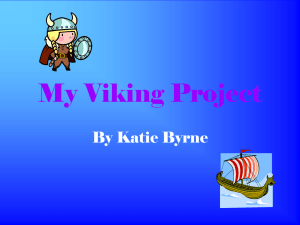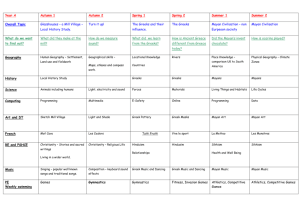overview-year
advertisement
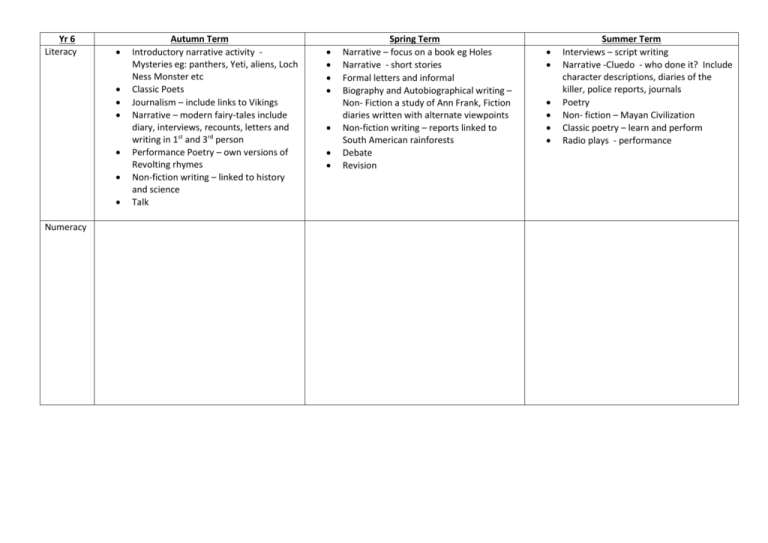
Yr 6 Literacy Numeracy Autumn Term Introductory narrative activity Mysteries eg: panthers, Yeti, aliens, Loch Ness Monster etc Classic Poets Journalism – include links to Vikings Narrative – modern fairy-tales include diary, interviews, recounts, letters and writing in 1st and 3rd person Performance Poetry – own versions of Revolting rhymes Non-fiction writing – linked to history and science Talk Spring Term Narrative – focus on a book eg Holes Narrative - short stories Formal letters and informal Biography and Autobiographical writing – Non- Fiction a study of Ann Frank, Fiction diaries written with alternate viewpoints Non-fiction writing – reports linked to South American rainforests Debate Revision Summer Term Interviews – script writing Narrative -Cluedo - who done it? Include character descriptions, diaries of the killer, police reports, journals Poetry Non- fiction – Mayan Civilization Classic poetry – learn and perform Radio plays - performance Science Living things describe how living things are classified into broad groups according to common observable characteristics and based on similarities and differences, including micro-organisms, plants and animals give reasons for classifying plants and animals based on specific characteristics Study of invertebrates and plants in local area, children try to classify Scientists to consider – Carl Linnaeus (plants) Came up with a classification system and a naming system using genus and species Evolution and inheritance recognise that living things have changed over time and that fossils provide information about living things that inhabited the Earth millions of years ago (New Walk Museum) recognise that living things produce offspring of the same kind, but normally offspring vary and are not identical to their parents (brief outline of genes – dominant) Identify how animals and plants are adapted to suit their environment in different ways and that adaptation may lead to evolution. Scientists to consider – Darwin and Wallace – evolution Mary Anning – Palaeontologist Living things Continue classification. Investigate the animals and pants found within South American environments. How do animals plants differ here than in UK. Animals, including humans Link to animals - Twycross?? Electricity associate the brightness of a lamp or the volume of a buzzer with the number and voltage of cells used in the circuit Light compare and give reasons for variations in how components function, including the brightness of bulbs, the loudness of buzzers and the on/off position of switches Use recognised symbols when representing a simple circuit in a diagram Scientists to consider – identify and name the main parts of the human circulatory system, and explain the functions of the heart, blood vessels and blood recognise the impact of diet, exercise, drugs and lifestyle on the way their bodies function describe the ways in which nutrients and water are transported within animals, including humans. understand that light appears to travel in straight lines use the idea that light travels in straight lines to explain that objects are seen because they give out or reflect light into the eye explain that we see things because light travels from light sources to our eyes or from light sources to objects and then to our eyes use the idea that light travels in straight lines to explain why shadows have the same shape as the objects that cast them, and to predict the size of shadows when the position of the light source changes. How does light behave – predict, male Shadow puppets, rainbows, investigate how objects appear to bend in water Scientists to consider – History The Viking and Anglo-Saxon struggle for the Kingdom of England to the time of Edward the Confessor Viking raids and invasion resistance by Alfred the Great and Athelstan, first king of England further Viking invasions and Danegeld Local Study – evidence of Viking invasions and Anglo Saxons within Leicestershire Geography South America physical geography, including: climate zones, biomes and vegetation belts, rivers, mountains human geography, including: types of settlement and land use use maps, atlases, globes and digital/computer mapping to locate countries and describe features studied The Viking and Anglo-Saxon struggle for the Kingdom of England to the time of Edward the Confessor Anglo-Saxon laws and justice Edward the Confessor and his death in 1066 A non-European society that provides contrasts with British history Mayan civilization c. AD 900; South American - Rainforests physical geography, including: climate zones, biomes and vegetation belts, rivers, mountains, human geography, including: types of settlement and land use, economic activity including trade links, and the distribution of natural resources including energy, food, minerals and water use maps, atlases, globes and digital/computer mapping to locate countries and describe features studied Geographical studies GMT and Time Zones Longitude and Latitude use the eight points of a compass, four and six-figure grid references, symbols and key (including the use of Ordnance Survey maps) to build their knowledge Local Study compare hours of sunshine and compare to South America RE Buddhism Expressive and visual art within religion Ideas about God DT Structures – Investigate Design, test and improve Mechanisms – linkages and levers Investigate how do they work, what do we use them for Design and test in real situation Product – Fairground buzzer game Investigate range of existing of existing products understand and use electrical systems in their products, such as series circuits incorporating switches, bulbs, buzzers or motors Design, adapt, make and evaluate product for specific client Art North American work Drawing – sketching light and shadow – local environment, landscape Textiles – weaving Painting – Picasso ICT PE FOLLOW EXISTING SCHEME Music JANE TO FILL IN French SUNDERLAND SCHEME Pastel work creatures of the rainforest Henri Rousseau – collage or painting link to rainforest Mayan Sculpture or inukshuks Mayan Pattern printing – Victor Bono
